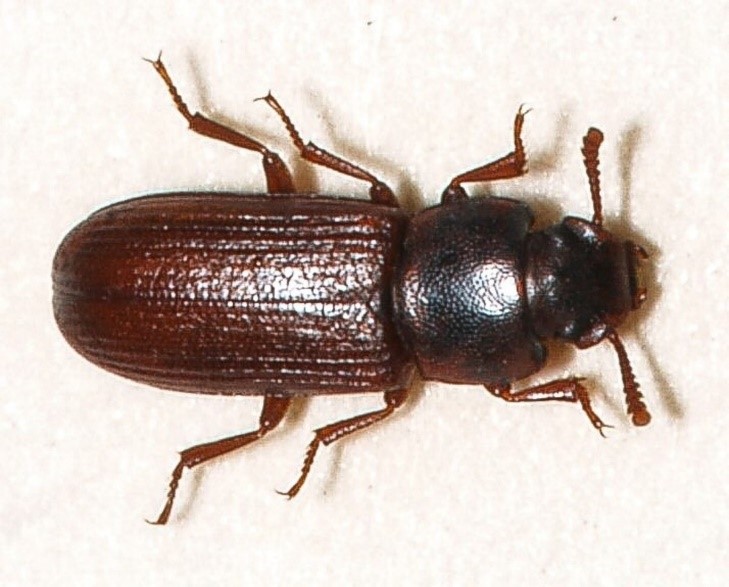- Mon- Sat: 8am-6pm WITA
- info@manulaspest.lk
Red flour beetle
The red flour beetle (Tribolium castaneum) is a species of beetle in the family Tenebrionidae. The red flour beetle attacks stored grain and other food products including flour, cereals, pasta, biscuits, beans, and nuts, causing loss and damage. These beetles can breed throughout the year in warm areas. The life cycle takes from 40 to 90 days, and the adult can live for three years. All forms of the life cycle may be found in infested grain products at the same time.

Cigarette beetle
Lasioderma serricorne, commonly known as the cigarette beetle, cigar beetle, or tobacco beetle, is an insect very similar in appearance to the drugstore. Adult cigarette beetles live for 2 to 4 weeks. Adult females lay as many as 100 eggs singly on food materials. The larvae can cause damage by feeding on a variety of stored products, such as dried products of animal and vegetable origin, nuts, herbs, spices, grain, and grain products. They may also chew through furniture fabric, books, manuscripts, and similar materials. Infested products are also contaminated by the presence of beetles, larvae, pupae, cocoons and insect parts.

Rice flour beetle
The Rice Flour Beetle, Tribolium confusum, is a common pest in many grain-based foods. Rice Flour Beetles are can live for over a year. Red flour beetles attack stored grain products such as flour, cereals, meal, crackers, beans, spices, pasta, cake mix, dried pet food, dried flowers, chocolate, nuts, seeds, and even dried museum specimen. The rice flour beetle is found in temperate areas, but will survive the winter in protected places, especially where there is central heat.

Khapra beetle
The Khapra beetle (Trogoderma granarium) is one of the most serious pests of stored grain products, especially under hot and dry conditions. It is very resilient and can survive in stored food, packaging, and transport facilities in very low numbers under difficult conditions. It is able to survive inactively for long periods. The larval stage can last from a month to several years. Larvae are capable of surviving without food for several years. Adult khapra beetles live for 12–25 days. The Khapra beetle occurs almost exclusively in closed environments in agricultural and urban areas. In agricultural areas, it is associated primarily with silos, storage, and animal holding facilities. In urban environments, it is found within human dwellings (synanthropic) and in stores, food stores, malt houses, seed processing plants, fodder production plants, dried milk factories, merchant stores, and stores of packing materials (used sacks, bags, crates).

Darkling beetle
Darkling beetle often found hiding under rocks or leaf litter and will come to light traps. Most darkling beetles (adults and larvae) scavenge on plant matter of some kind, including stored grains and flour. Some species feed on fungi, dead insects, or even dung. Female darkling beetles deposit their eggs in the soil. Larvae are worm-like, with slender, elongated bodies. Pupation usually occurs in the soil. Many darkling beetles will emit a foul-smelling liquid to dissuade predators from dining on them. Darkling beetles live, in both temperate and tropical habitats. Darkling beetles can cause damage to almost every part of a poultry facility. They can burrow into wood structures and tunnel through insulation. They can cause damage to sill sealers and vapor barriers. They can even create spaces between walls, concrete, and flooring. Darkling beetles can carry diseases such as E. coli, turkey coronavirus, Salmonella, Marek’s disease virus, Newcastle disease virus, poultry tapeworms, infectious bursal disease virus (IBDV), astrovirus, RSS orthoreovirus, and coccidiosis protozoa.


We are accredited as a fully licensed and insured Pest Control Company, as our pest control treatments meet all the safety regulation of the society.
Hotline : (+94) 11 44 30 956
Phone
+94 11 44 30 956
info@manulaspest.lk
Location
No 38/1/4 Sangarama Siddamulla Piliyandala

